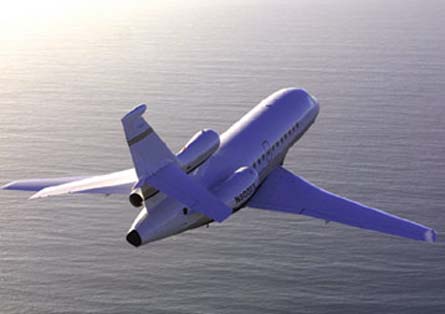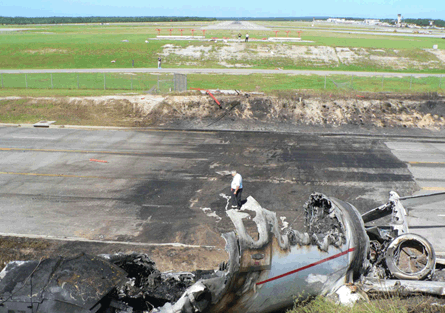The Flight Safety Foundation has assessed global corporate aviation safety in 2010 as fairly good based on accident figures, but similar numbers have often been achieved in the past decade, so no serious claims for improvement can be made (see graph below).
This is reinforced by the fact that, although business aviation activity has been making a comeback since the grim days of 2009, activity is still lower than in the heady days of 2007, so when the rates for serious accidents are known, they may be less flattering than the simple numbers. There were eight serious business jet accidents globally in 2010, a figure that has been recorded in four of the years since 2000 and was bettered in 2009.
The new requirement for certain business aircraft operators to run a safety management system (SMS) may benefit safety performance in the long run. The relevant standard is laid out by the International Civil Aviation Organisation in Annex 6 Part 2. This states a requirement for operators of business aircraft with a take-off mass of more than 5,700kg (12,500lb) to run an approved SMS, but the measure became effective only in November last year, so the results are unlikely to show for some time yet, especially because even some global "role-model" aviation agencies, such as the US Federal Aviation Administration, remain a long way from creating regulations based on the ICAO standard. So far, it has only issued guidelines for setting up an airline SMS.
 |
|---|
© Dassault |
Fortunately, the International Business Aviation Council (IBAC) and member organisations such as the National Business Aircraft Association have developed a code of best practices to help operators set up an SMS tailored for business aircraft operations, scalable from single-aircraft/single-pilot operations up to large multi-aircraft flight departments. The NBAA offers a toolkit to help operators develop and implement an SMS that meets ICAO standards, and an SMS e-learning course developed jointly with IBAC and FlightSafety International. Many, but by no means all, US business aviation operators have used International Standards for Business Aircraft Operation (IS-BAO) to set up an SMS, and a recent review of results carried out for the NBAA has proved it does have a measurably beneficial effect on safety (summarised later in this article).
An area of concern for European operators has been the flight time limitation rules that were due to be introduced in April 2012, but have now been delayed. European Business Aviation Association president Brian Humphries says talks with the rulemakers have been positive in the sense that the regulators accept that business aviation is so different from airline operations that it would be inappropriate to apply the same rules to both sectors. Humphries points out that corporate and business aircrews rarely fly more than 400h a year, unlike the 700h or more flown by airline crews, so the potential peril faced by business aviation pilots is tiredness associated with long hours rather than accumulated fatigue from intensive flying over weeks or months. For three years, the EBAA has been engaged in a fatigue study within the sector, managed by US sleep scientist Dr Mark Rosekind and based on a survey that garnered 760 responses, and is using the results to develop a fatigue risk management system for business aircraft operators.
Another piece of European regulation that has been pushed back concerns the operation of what Europe categorises as "complex motor-powered aircraft", which basically means jets of any weight, or aircraft above 5,700kg whatever their propulsion. Humphries says these rules are being drafted from scratch, which makes them less complicated. The motivation for drawing the rules up is the advent of light jets that could, theoretically, be flown by pilots unaccustomed to high-performance machines with complex systems, and the regulations are intended to set sensible training and qualification requirements. Humphries says he is encouraged by the regulators' readiness to engage with the industry on the issues.
 |
|---|
Business jets generally suffer the same types of accident as airlines, but statistically they are significantly more likely to have a runway excursion than airliners, according to the FAA. Because runway excursions or overruns are the most common type of commercial aircraft incident, simple mathematics suggest business aviation's exposure to this risk is unacceptably - and perhaps avoidably - high, and a greater awareness of this risk among pilots would, theoretically, help to reduce it.
Among the eight serious accidents to business jets globally last year, six were approach and landing accidents and, of those, three were runway excursions.
Despite the Flight Safety Foundation's best efforts to raise awareness of this high-risk accident category among corporate and business aircraft pilots, there has been no reduction - yet - in the excursion rate. In fact, according to FSF and IATA figures, there is a slight upward trend.
About 80% of runway excursions or overruns happen in the landing phase, and only 20% during the take-off (or abandoned take-off) run. For that reason, the vast majority of them come within the ambit of the FSF's Approach and Landing Accident Reduction (ALAR) programme, for which it provides a toolkit training package.
Because excursions are so common, the FSF decided to issue a specific Runway Excursion Risk Reduction (RERR) toolkit in 2009.
It is difficult, statistically, to isolate all the reasons why business jets, in particular, face an even higher risk of runway excursion than airlines do, but because being high and fast on the approach is a common reason, it is impossible not to wonder whether frequent flights to unfamiliar destinations, and the higher probability of landing at small aerodromes, are factors. The RERR therefore takes the stabilised approach lessons from the ALAR and adds "stabilised landing" criteria. Put simply, the RERR exhorts pilots to ensure runway contact in the touchdown zone at the correct speed, and the immediate application of braking and/or reverse thrust, combined with checks of speed against distance to go. Avoiding tailwind landings is obviously desirable.
Robert Sumwalt, a board member at the National Transportation Safety Board, presented, at the last Corporate Aviation Safety Seminar, the details from the investigation into a fatal runway excursion by a Bombardier Learjet 60 as an example of the pitfalls business jet pilots may have to cope with. The accident took place in September 2008 at Columbia Metropolitan airport, South Carolina, when a chartered Global Exec Aviation aircraft suffered a multiple tyre burst during the take-off run, but because of the causal complexity of the accident, the report was not published until relatively recently.
 |
|---|
Global Exec Learjet 60 crash |
The trigger for the tyre burst, according to the NTSB, was the failure of Global Exec to check tyre pressures, which had been allowed to fall to almost half the required value. The resultant carcass flexing during take-off run created heat, leading to tyre failure above the V1 take-off decision speed. The captain's decision to abort the take-off despite being faster than V1 preceded a nightmare sequence of system failures that resulted in a very fast overrun and the death of both pilots and two of the four passengers. Tyre fragments had caused damage to cabling and hydraulic lines in the wheel wells, which led to impaired braking and the failure of the thrust reverser buckets to deploy, leading to high forward thrust when reverse was commanded. The cause, says the NTSB, was failure by the operator to maintain tyre pressures properly, and the captain's decision to abort take-off beyond V1. Contributory factors were the vulnerability of the Learjet 60's design to critical failures following wheelwell damage, the lack of an FAA requirement that training should include tyre failure during take-off, and poor crew resource management.
A good SMS backed up by a management-led company safety culture would have picked up all but the aircraft design shortcomings shown up by that accident - and maybe even those, if the results from a recent five-year survey of 58 US companies with a business aviation flight department are to be believed. Pete Agur, founder of the Georgia-based VanAllen consultancy that carried out the study, reported to the NBAA leadership conference in San Diego this February that the beneficial safety results are directly proportional to the degree of management buy-in to the organisation's SMS. "We have solid proof," he said.
"It's up to you," Agur told the conference. "You must sell safety, both uphill to management above you and downhill to people in your flight department."
In carrying out the study, VanAllen assigned what it calls a risk tolerance rating (RTR) to four levels of company management in each of the 58 companies. Working from the top down, Agur assigned an RTR to the company chief executive, the upper-level executive to whom the flight department was responsible, the aviation department manager and the trip commander. The scores for the latter two were weighted to take account of their very direct influence. "Behaviours, as opposed to stated beliefs, were also given double value," said Agur. "We listened to what they said they believed, and then compared that to what they actually did."
Each of the management groups within a company emerged with an RTR that categorised them on a scale of five: world class, best practices, standard practices, substandard practices, and unacceptable practices.
The results were categorical, said Agur. "Of those with an overall RTR that was substandard or unacceptable, 100% suffered accidents or safety events during the study." Among companies with standard practices, 22% suffered a safety event, and among those with an overall RTR indicating best practices, only 13% had a safety event. Commenting on those at the top of the scale, Agur said: "Companies with an overall RTR that qualified them as world-class in safety, exactly zero were involved in any safety events. Zero. Does conscientiously applied SMS work? The facts speak for themselves, and the data falls where it will."
VanAllen reviewed nine companies that had a serious safety event that forced them to change the way they operated. They had all previously been rated in one of the bottom two categories, but after the changes were applied, their risk tolerance ratings roughly halved, raising them to best practices level.
Meanwhile, the NBAA says the FAA is unlikely to mandate SMS domestically any time soon, but warns N-registered international operators that they will be expected to comply with Annex 6 Part 2 by some of the countries where they operate, particularly in Europe.
Source: Flight International
















